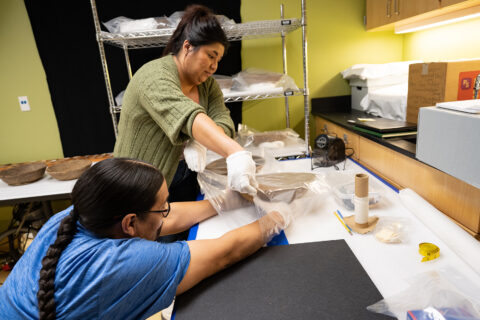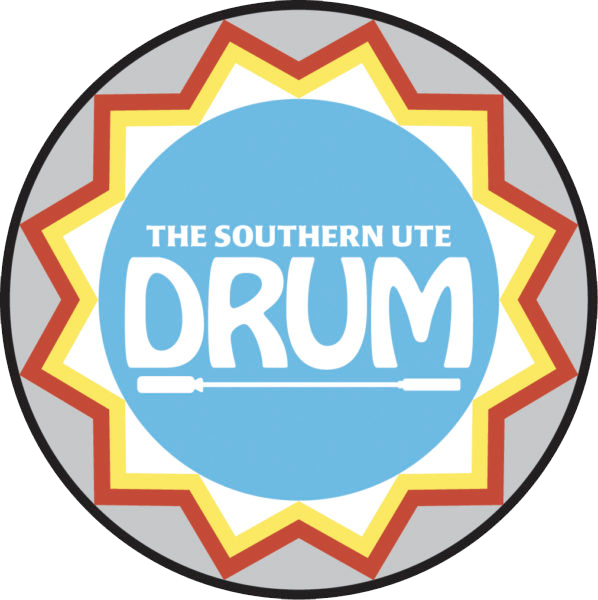The Southern Ute Museum acquired a donation of over 33 traditional baskets on Wednesday, Feb. 22 from Pendleton Woolen Mills, Inc., and the Bishop family, who has owned the company for over six generations. The donation was originally proposed back in August of last year and was accepted by the museum’s Collections Committee soon after.
Since receiving the donation, Southern Ute Museum has begun the lengthy process of accessioning the items to be included within their existing permanent collection. One of the challenges in receiving this particular donation is trying to uncover the history behind the baskets.
“Normally, what we would do is we would have a lengthy intake process where we would do a lot of interviews and questions and try and get some answers,” Southern Ute Museum Director, Susan Cimburek said. “That’s always a challenging thing — to get this information [at first]. We will then start building the item’s records.”
According to Cimburek, what is currently known about the collection is that all of the baskets have been sitting in storage for over 50 years as part of a personal private collection of the Bishop family. Many of the baskets are believed to be dating as far back as the mid to late 1800’s – and the collection features baskets from other tribes across the United States. Out of the collection, six are believed to be traditional Ute baskets which feature techniques, colors, and artwork seen historically within the Ute bands.
“They are very similar to some examples in the Smithsonian that come from John Wesley Powell’s Expedition,” explained Museum Collections Manager, Tallias Cantsee. The Powell Geographic Expedition occurred over the course of 98 days in 1868, starting in Wyoming and ending near the current Nevada and Arizona border.
After receiving the donation from Pendleton in a series of tightly compacted boxes, members of the Southern Ute Museum Collections staff began the delicate series of tasks relating to minor conservation of the collection. First, documenting the condition of the item, giving an accession number for the digital catalogue, including any photos and research for the catalogue, vacuuming the item for contaminants, and pest control management. From here, extra steps can be taken to conserve the items, including more specialized jobs like restoration. Finally, the items will be placed in the archival room or vault, where space is set aside, and their location is documented in the database.

“It’s important that these [baskets] are here so we can provide top notch, conservation care,” Cantsee said. “Here we are able to provide a quality of care that can provide longevity [to the collection]. This is stuff that should be cared for by tribal peoples.” Cantsee explained that many of the baskets are in acceptable condition, but most have not been properly taken care of in a way that a museum or someone knowledgeable in handling artifacts could provide.
“We know here at the Southern Ute Museum that we can give the baskets the best possible care and to have them live the longest life they can — but also giving access,” Museum Collections Assistant, Sheree Mann said.
Access is an important step in the museum procedure and allows for collections to be seen in the public, which allows for education and research to be done with items acquired by the museum.
“I think one of the ultimate goals as a museum [which has] a public mission, is an obligation to serve the public in some way. The main thing we that do is that we keep these historical artifacts, and we make them accessible to people,” Cimberek explained. “We don’t keep stuff just to keep it. It’s here so people can learn from it and appreciate it. That’s a big part of our mission.”
Access can be done in a variety of ways by doing a “full interpretation” within a permanent or temporary gallery, hosting education programs, allowing researchers to come in and work with the collection, or even putting them online in a digital exhibit for public viewing.

“The end goal here is to add to our current basket collection which is also a multicultural collection in the hopes of creating a basket exhibit that is a headliner,” Cantsee said. The Southern Ute Museum currently has a collection of around 230 baskets with 78 percent of the baskets being specifically Ute made. Most of the collection is a part of the White Mesa Collection, which was featured when the museum’s new facility opened in 2011.
With the newly acquired donation, the museum hopes to do an exhibit featuring the pieces from this collection as early as next year, which could potentially allow for collaboration with Pendleton or other agencies in the area.
“It’s possible in next year’s temporary exhibit we might highlight this collection,” Cimburek said. “Because it is such an interesting collection, it could be fun to collaborate with some other cultural institutions in the area.”
The accession of the baskets also showcases an importance to museum staff as to why the baskets and their techniques must be preserved for future generations.
“To me, it is really crucial to have examples of traditional Ute basketry as there are only so many basket makers left,” Cantsee said. “It’s still the same design as it was back in the late 1800’s. That really shows the continuum of tradition.”






